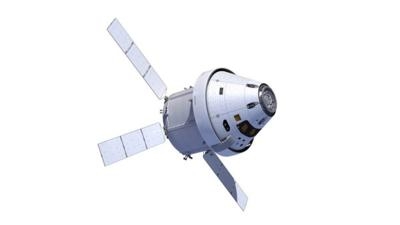Wed, Nov 27, 2013
European ATV Technology Under Technical Review By ESA, NASA
A milestone in developing Europe’s contribution to NASA’s Orion crew vehicle, expected to take human crews beyond Earth orbit later this decade, has been set for next May. The period until then will allow for an in-depth design analysis for the proposed European hardware. Using Automated Transfer Vehicle (ATV) technology proven in flight, Europe will contribute hardware and expertise to the Orion Multi-Purpose Crew Vehicle.

The activity highlights the major involvement of ESA and European industry in this cornerstone NASA project, and is based on the long-standing partnership of the two Agencies across many areas of human and robotic spaceflight.
In 2011, an initial forecast for Europe’s redevelopment of existing ATV technology, to be used in the Orion Service Module, foresaw the project stage known as the Preliminary Design Review (PDR) in November 2013. However, a series of technical reviews has revealed that additional time will be required for finalizing some design trade-offs, the maturity of essential documentation needs to be increased, and recent updates of design modifications and the technical baseline need to be processed.
As a result, it has been decided to delay the PDR by six months.
The overall effect on the project’s schedule is still under investigation. It is the aim not to affect the critical path of the project and to minimize the effect on the overall schedule. Specific tasks forces have been set up to work on prioritized activities, the industrial team has been reinforced and a closer cooperative working approach with NASA and US industry has been agreed. “Decisions on ESA’s contributions are critical because we know NASA plans to use Orion for a long time, to conduct new missions, including human missions to asteroids,” says Nico Dettman, Head of ESA’s ATV program.

“We need more time to look at options and ensure we make the right design decisions at this stage.”
The two Agencies are continuing close collaboration and working-level cooperation, extending to the US and European industrial partners supporting Orion. “We have very challenging objectives and we are implementing new techniques in our engineering design process, including probabilistic reliability analysis,” says Nico. “This extension will help both Agencies make the right design decisions, and ultimately boost safety as we will increase the confidence we have that the design and manufacturing will have been done right.”
(Image provided by NASA)
More News
“The rapid succession of contracts indicates that the Chinook will continue to play an important role in the US Army’s family-of-systems, particularly in a contested lo>[...]
Aero Linx: African Business Aviation Association (AfBAA) AfBAA is dedicated to promoting the understanding and advantages of Business Aviation across Africa. Our mission centers on>[...]
Postaccident Examination Revealed That The Right Brake Linings Had Exceeded The Manufacturer’S Serviceable Wear Limit Analysis: The pilot was taxiing from the fixed-base oper>[...]
Also: USAF Pilots, Advanced Aircrew Academy, ATC Hiring, Hop-A-Jet Sues Pan American is attempting a comeback. Aviation merchant bank AVi8 Air Capital, alongside Pan American Globa>[...]
Also: DHS Under Fire, Air New Zealand, ALPA Praises Bipartisan Bill, Spirit Budget Cuts The Minnesota Pilots Association has issued an advisory regarding overflights of the Red Lak>[...]
 Aero-News: Quote of the Day (10.24.25)
Aero-News: Quote of the Day (10.24.25) ANN's Daily Aero-Linx (10.24.25)
ANN's Daily Aero-Linx (10.24.25) NTSB Final Report: Cirrus SR22
NTSB Final Report: Cirrus SR22 Airborne-Flight Training 10.23.25: PanAm Back?, Spirit Cuts, Affordable Expo
Airborne-Flight Training 10.23.25: PanAm Back?, Spirit Cuts, Affordable Expo Airborne 10.22.25: Rez Takes Plane, DJI v US Drone Ban, HK 747 Cargo Accident
Airborne 10.22.25: Rez Takes Plane, DJI v US Drone Ban, HK 747 Cargo Accident




